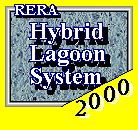
COPYRIGHTS
1999-2009 RERA
All right reserved.
Any Unauthorized
Copying
or Using Prohibited.
Preface
Table
of Contents
Foundation
Hybrid
Lagoon System
Case
Study
Applications
Proposals
28.
Future Plans for Environmental Protection
(2):From Facilities
for Human Waste Processing to Sewage Treatment Facilities.(600
kliters/day, 40,500 m3/day)
One feature of the hybrid lagoon automatic control system lies in its capacity for organic treatment of various types of wastes, from household waste water and other low-concentration wastes (100-200 mg/liter BOD) to waste water from livestock breeding and food production, human waste and other high-concentration wastes (5,000-10,000 mg/liter BOD).
This versatility is an important feature of the hybrid lagoon automatic control system. As a consequence, this system has the flexibility to meet the changing demands of society for waste treatment. Since waste treatment plants are built for use over extended periods of time, by using this versatility of such facilities, they can immediately after construction be used for treating raw human waste, and then, with the construction of sewage networks, be employed in treating a mixture of human waste and waste water, and be operated as terminal treatment facilities after sewage networks are completed.
In the case of facilities for treatment of raw human waste (600 kliters/day x BOD 13,500 mg/liter), following the guidelines for human waste treatment facilities established by the Ministry of Health and Welfare, the quantity and concentration of human waste treatable may be estimated as follows.
Facilities for treatment of raw human waste (600 kliters/day x BOD 13,500 mg/liter) could begin by treating human waste exclusively, and then, after a period of treating a mixture of human waste and waste water. finally begin operation as a terminal sewage treatment plant, processing 40,500 m3/day x BOD 200 mg/liter.
To convert to equivalent population, if we assume 1.4 liters of human waste per person per day and 200 liters of waste water per person per day, then hybrid lagoon facilities consisting of four basins each 60 m in diameter, with an effective capacity of 12,500 m3, and requiring power for aeration of 175 kW, could begin operation as human waste treatment facilities for 420,000 persons, and subsequently be used for treating waste water generated by a population of roughly 200,000.
wastewater
microorganism reaction basin
microorganism separation basin
treated water
returned sludge
intake
discharge of treated water
Diagram of single-basin facilities
hybrid lagoon basin
Cross-sectional diagram
Light-loaded state
saturated oxygen concentration, mg/liter
Properly loaded state
aeration process
sedimentation process
time (reduction of aerated volume)
(maintenance of aerated volume)
Overloaded state
(increasing aerated volume)
Changes in dissolved oxygen concentration waveform
Block diagram of automatic control and data processing systems
unattended operation
automatic control instruction
instruction
sequencer
microorganisms
measured values
conversion equipment
recorder
selection
A/D converter
30 data/sec
?? program creation/modification
display
memory device
on-site supervisor
for maintenance/control
supervisor's telephone
telephone at facilities
leased communication circuit (unattended response)
telephone at remote location
monitoring personnel
remote monitoring
Performance satisfactory despite the low concentration of activated sludge, and facilities operating smoothly. In future, as amount of sludge increases, should reach planned performance level. Lead, mercury, organic phosphorus compounds, normal hexane extracts, phenol, chrome, arsenic, other impurities not detected .
households (generating waste)
waste water from rinsing
household waste water
raw waste
(treatment)
hybrid lagoon facilities
(high-level treatment)
(treated water)
discharge into public water systems
(excess sludge)
spring, autumn
(sludge reduction processing)
dispersion in fields, pastures
Basic Design of Newly Installed Human Waste Processing
Facilities Outline of LLSB Activated Sludge Treatment Processes and Block Diagram of Automatic Control System